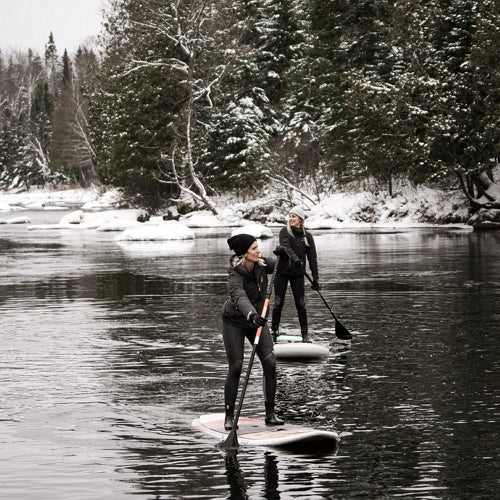Winter Paddleboarding? Here’s Everything You Need to Know!
Have you ever dreamed of paddling in a fairy-like winter setting where trees are covered in snow? Winter paddle boarding is not for the faint-hearted, but it’s definitely possible.
In the summertime, I’m often called to take my board out when I come across a body of water. In winter, I feel the same way, especially when the water is mirror-like and there’s a light snowfall.
With several exciting winter SUP excursions now under my belt, allow me to share some of my tried-and-true tips and tricks for a safe experience on the water.
What Equipment Should You Bring?
The basics are the same as in the summer: your board, your paddle, your leash which will help you get back onto your board quickly if you fall, and most importantly, your lifejacket or PFD (Personal Floating Device), a floating cord, a whistle, and a watertight flashlight. If you have an inflatable paddle board, it's best to inflate it outside! If you prefer to inflate it indoors, add a few more PSI than usual as air contracts in the cold, making your board less stiff, and thus, less stable. If you have a hard board, handle it with more care than usual and allow some time for it to adapt to the temperature outside before putting it in the water. A drastic temperature switch can cause damage.
To print : Checklist Paddle Board Excursion

Selecting Your Location
Selecting an ideal location in the winter is particularly important. Be more cautious and less adventurous than in the summer. Choose bodies of water that you are familiar with and make sure that there’s a safe entrance to avoid falling in the water. Important fact: Lakes freeze over much faster than rivers. As winter progresses, you’ll have more opportunities for paddling on rivers. When the time comes, be sure to choose a river with a safe and suitable current for your skill level.
Check the Water Temperature
Venturing out on the water when the temperature outside is -15°C is a very personal choice. Be sure to check the wind chill. If the wind chill s prominent, you'll have to deal with both the cold and the wind, which may make your outing less enjoyable. To facilitate your experience, choose days when the weather is mild. If the sun is out, all the better! Its rays will help warm you up.
What to Wear?
The first thing to consider when tackling the water in winter should be your choice of apparel. Word of advice: Don’t head outside with just your winter suit, mittens and boots thinking ‘‘I WON’T FALL IN THE WATER! C’MON! I AM A SUP PRO!’’ Mistakes are human nature, even for super humans.
A good drysuit or wetsuit is crucial. Why? If you fall in the water, your drysuit will keep you nice and dry and your wetsuit will maintain your body heat at a minimum. For a wetsuit, I recommend wearing a 4/3 mm, a 5/4 mm or even a 6/5 mm, as well as booties (min. 5 mm) and gloves (min. 3 mm for flexibility). If you want, you can also throw on a tuque and a windbreaker over your suit for added warmth.
If you’re paddle surfing on the ocean or a river, opt for a 6/5 mm wetsuit with a hood. Your body will thank you once you get in the water!


What to do if You Fall?
Falling in the water is, unfortunately, part of the risks when practicing SUP in the winter. This factor adds an exciting challenge when paddling on an icy river. You can’t be afraid of getting wet though; you just need to know how to react.
The first thing to do if you fall is to stay calm.
Despite the shocking effect that the icy water may have on you, it’s important not to panic. Bring your head above the water, take two or three deep breaths while swimming in place as you locate your board.
Whether you’re wearing a wet or a dry suit, such a fall may bring your outing to a halt for the day…and that’s okay! It’s better to find a spot to warm up quickly to avoid hypothermia. A good trick to avoid hypothermia is to stay active to generate body heat Once back on your board, paddle at a steady pace until you reach shelter.

More Tips
- Always paddle with a friend! You can also let your friends and family know about your whereabouts and plans.
- Stay close to shore. Avoid venturing into the middle of a lake at all costs.
- Stay close to your cottage, your house, your car. You want your shelter to be near and accessible.
- Aim for short outings at first to get used to the cold. Your toes will thank you!
- Pack a thermos filled with soup or a hot drink to help warm you up quickly when you get out of the water.
You're now ready to experiment winter from another angle! Enjoy it, you may well get hooked! You can even do like our ambassador, Alex, and explore Iceland on your paddle board!


Leave a comment